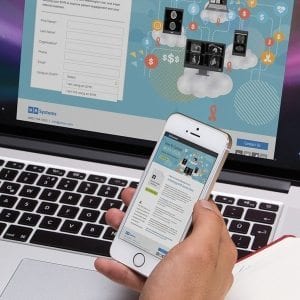
With a growing importance for online commerce, businesses are relying more on online sales to drive revenue, especially during the holiday season. In fact, in 2015 alone, online shopping increased 19% year-over-year and, during the holiday season (November through December), online sales increased by 6%. Even though some experts consider this to be a dying mode of communication, email marketing drove 22.1% of online sales in 2015.
Along with email marketing, the online purchasing funnel is becoming more robust and complex, which tells us that increasing online sales are a result of successful omnichannel marketing. In other words, buyers are using a combination email, mobile, social, display, web, and store before making a purchase.
Example of an Online Acquisition Lifecycle
In many instances, buyers’ first shop in a physical store, and then open their e-receipt later. After opening their e-receipt, the buyer then proceeds to open and browse the store online, with little intent to buy. The buyer exits the browser and thereafter receives and opens a browse abandonment email, opens the site again, and makes a purchase. What we’re noticing here is that we’re now dealing with omnichannel marketing as well as cross-device use.
Best Practices For Improving Browse and Cart Abandonment Rates
If you are simply having trouble driving people to your e-commerce site in the first place, try incorporating light boxes on your mobile or website sites to acquire new emails. Your annual list is anticipated to grow approximately 20% as found during 2015.
If you have no problem driving people to your site but have a hard time converting them, here are a few ways you can focus your efforts to improve acquisition rates this holiday season:
Timing Is Everything: We don’t want to dilute potential buyer’s inboxes, but we also don’t want to let them forget about what they were looking to purchase. The timing between when someone left your site to when they see your email should ideally range between 1-5 hours.

Know Your Audience To Master Content: If your potential buyer has been looking at a very specific product on your website multiple times, call attention to that specific product in your messaging. If your potential buyer is browsing a range of products, focus on passive messaging. Based on the buyers’ behavior, act accordingly.
Thoughtful Nurture is Necessary: Incorporate a multi-email campaign that has a combination between soft and hard sells. Saying the same message multiple times may result in your domain getting spammed. If they continue to browse without purchasing, include a complimentary item or highlight other searches that people similar to them look at.

Results, Results, Results…
It always comes down to how to gain the best return on investment (ROI). And so, A/B testing these best practices focus on improving just that. Successful optimization of these best practices can result in leveraging the following statistics:
- 42% of revenue comes from browse abandonment nurture campaigns
- 75% of conversions from e-commerce campaign are attributed to personalized product recommendations
Bottom line: tap into these missed opportunities to increase revenue.
Data provided by Listrak.








